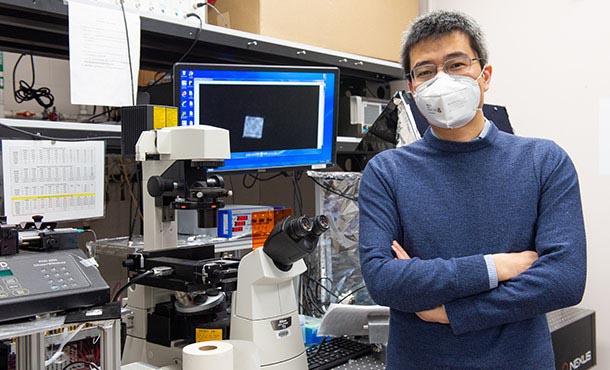
Weihua Guan, assistant professor of electrical engineering at Penn State and recipient of a five-year, $500,000 National Science Foundation Faculty Early Career Development Program (CAREER) Award. IMAGE: PENN STATE COLLEGE OF ENGINEERING
NSF CAREER Award to be used for developing new method of nucleic acid testing
2/15/2021
By Sarah Small
UNIVERSITY PARK, Pa. — The development of more sensitive, portable and fully electronic nucleic acid testing (NAT) is underway, with efforts led by Weihua Guan, assistant professor of electrical engineering at Penn State and recipient of a five-year, $500,000 National Science Foundation (NSF) Faculty Early Career Development Program (CAREER) Award for this research.
NAT, a method of analyzing biological samples in order to diagnose certain diseases, has been critically important in the infectious disease, food safety and environmental monitoring fields. However, the current methods of NAT are not sensitive enough to detect trace amounts of diseases on the single-molecule level and often involve equipment that is too large to be easily portable.
“Previously, NAT devices used an optical detection method, which can of course be minimized in size but are still bulky,” Guan said. “With this NSF CAREER Award, we are going to apply a totally new platform based on single-molecule electronics. We aim to make it more portable and usable at point of care.”
The platform, known as a solid-state, nanopore-based, single molecule counting platform, will differ from previous NATs not only in the use of electronics exclusively, but also in the nanopore sensing principles.
Nanopores are very tiny holes through which a single molecule can fit. Nanopore sensing refers to the act of threading a molecule through one of these tiny holes and using its electronic signal to learn about the molecule. Often nanopore sensing relies on naturally occurring pores in cell membranes. In this project, researchers will fabricate the nanopores with solid-state materials that are compatible with modern electronics.
“We recognize all of the challenges in terms of, first, its fabrication,” Guan said. “You can imagine drilling a hole at the nanometer size is a pretty big challenge. Second, even if we can do it on an individual scale, it is extremely challenging to scale up to repeatedly fabricate the pores with the required precision. For example, in one batch, we can do a five nanometers pore, for the next batch, the size maybe seven nanometers. The shape would also be different. These variations created challenges for reliably analyzing the molecule.”
However, this is where one of the most innovative factors of this new NAT comes into play: with the electronics nanopore sensing, molecules can be easily counted instead of sensed by their shape or size.
“As long as there is a single molecule coming, I can detect it,” Guan said. “If you have a second one coming, I can register as two. This is a single molecule technique as opposed to a bulk technique, which is going to outcompete in the sensitivity perspective.”
Because of the single molecule counting, the differing size and shape of the fabricated pores would no longer be an issue. Because the counting method is more sensitive and easier than previous methods, it also has the potential to shorten diagnostic time.
“Imagine there is a gate to a conference hall, and you are trying to recognize how many people are entering the hall,” Guan said. “Counting heads is much easier than analyzing each person’s features. The traditional nanopore sensing method was like analyzing each person’s face, and this new method is like counting each person instead.”
Guan plans to validate the NAT with representative samples containing malaria and SARS-CoV-2. Building off of previous NAT research as it relates to the detection of COVID-19, the disease caused by SARS-CoV-2 virus, Guan will collaborate with faculty members across the University, including in the College of Medicine, the Huck Institutes of the Life Sciences and the Materials Research Institute.
NSF CAREER Awards offer the NSF’s “most prestigious awards in support of early-career faculty who have the potential to serve as academic role models in research and education and to lead advances in the mission of their department or organization,” according to the foundation’s website.



